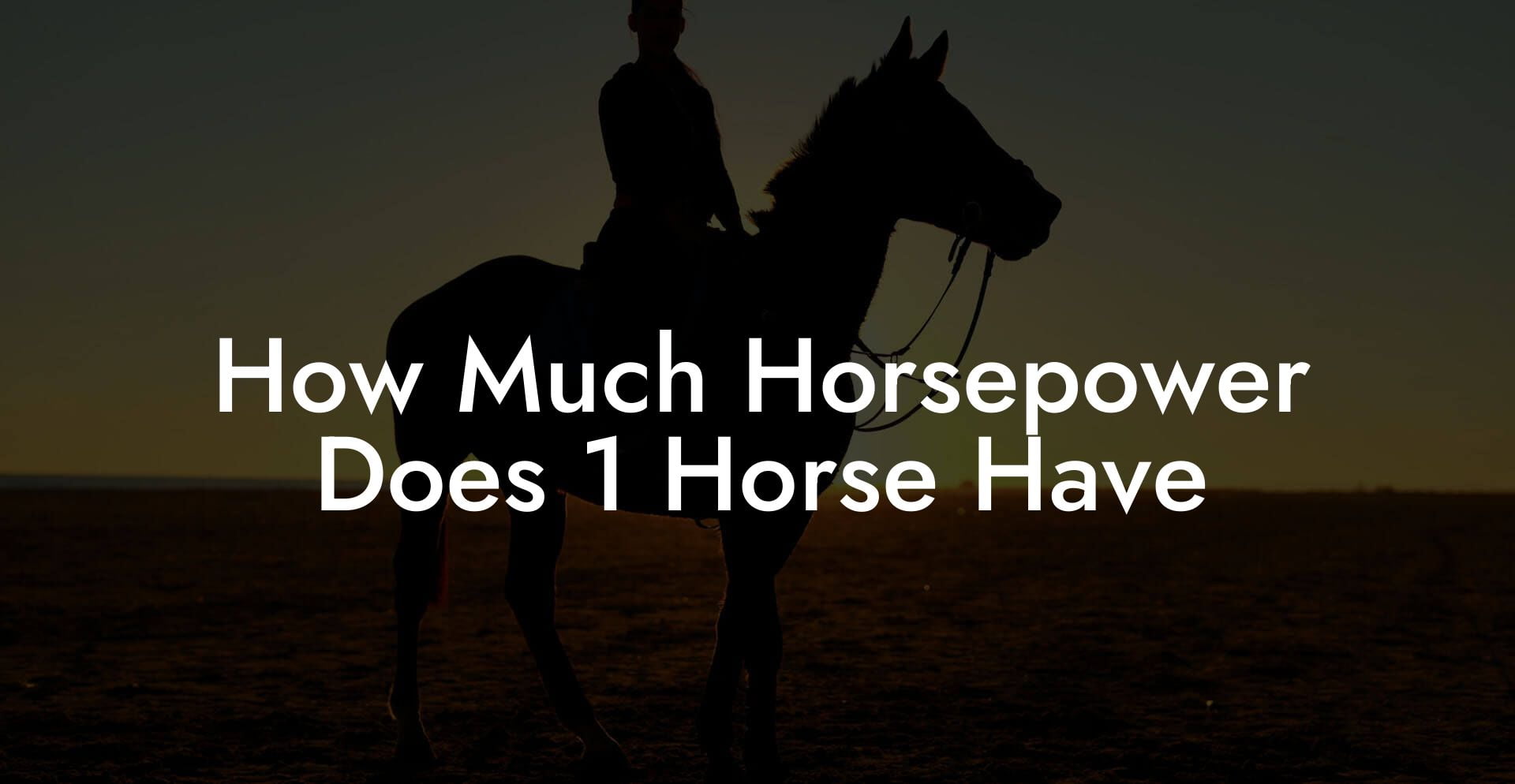Ever wondered if a single horse really packs the same punch as a revving engine? Grab your riding boots and your inner gearhead because we’re about to gallop into the fascinating world of horsepower and horse care. Spoiler alert: it’s a wild mix of myth-busting science, historical trivia, and practical tips on keeping your four-legged friend fit, happy, and ready to hit the trails, whether in a field or on the racetrack of life.
Quick Links to Useful Sections
- The Science Behind Horsepower: More Than Just a Number
- Historical Origins: From stable to Steam Engine
- How Much Horsepower Does 1 Horse Really Have? Debunking the Myths
- Comparing Engine Horsepower and Real Horse Power: The Key Differences
- Equine Physiology 101: The Inner Workings of Horsepower
- Practical Horse Care: Nourishing Your Four-Legged Powerhouse
- Grooming and Maintenance: Keeping Your Horse’s Engine in Top Shape
- Equine Nutrition & Fitness: Fueling the Fire Within
- Common Horse Care Challenges (And How to Tackle Them)
- How Horsepower Influences Modern Engineering, and Equine Enthusiasm
- Resources and Community Support: Your Next Steps
- Integrative Equine FAQs: Your Questions Answered
- Your Journey to Master Horsepower and Equine Wellness
The Science Behind Horsepower: More Than Just a Number
When we talk about horsepower, we aren’t just tossing around a fun phrase; we’re referring to a concept that transformed the world of industry and engineering. In simple terms, horsepower is a unit of measurement that quantifies the rate at which work is done. But how does this relate to our equine companions, and more importantly, how does it affect those who care for them? Let’s break it down.
The concept of horsepower was popularized in the 18th century by the ingenious engineer James Watt. Trying to sell his steam engines, Watt needed a way to communicate their power to a market that was used to the raw, muscular strength of horses. By approximating that one horse could sustain 550 foot-pounds of work per second, Watt managed to bridge the gap between the charming beast and the sleek machine. However, in reality, the average work output of a live horse varies depending on factors such as breed, age, training, and overall health.
It’s critical to realize that horsepower as a measurement for engines doesn't directly translate to the physical strength of a living horse. Instead, it was more a marketing tool, a convenient conversion factor. Today, when we ask, “How much horsepower does 1 horse have?” we’re really exploring an interesting blend of physics, history, and a bit of equine biology.
In the modern world of SEO and content optimization, understanding terms like "horsepower," "engine power," and even "horse care" are all part of a semantic cluster designed to hook both animal enthusiasts and home mechanics alike. Whether you’re fixing up your stall or tuning in to your favorite podcast about the latest in horse wellness, the interplay between horsepower and real-life horse care has never been more relevant to a Gen-Z or millennial audience.
Historical Origins: From stable to Steam Engine
The story of horsepower is as riveting as a day at the races. Back in the 1700s, when horses were the primary mode of transportation and heavy labor, engineers needed a way to market their new inventions. Enter James Watt and his ingenious conversion: if one horse could move a certain amount of weight over a distance within a specific time frame, then his engines could be advertised as having “horsepower” equivalent to that amount.
Watt’s calculations indicated that a well-conditioned draft horse could produce about 550 foot-pounds of work per second. Though this is more an approximation than an exact science, it served as a solid foundation for comparing the output of steam engines to that of horses. The term “horsepower” quickly became embedded in the lexicon of industry and technology.
Over time, the practical use of horsepower evolved. Today, we use it to describe engine power in cars, lawn mowers, and even chainsaws. But while the number might seem to romantically recall a simpler time when horse and rider were the essence of progress, it’s important to remember that real horses are living, breathing creatures whose capabilities extend far beyond a single numeric value.
How Much Horsepower Does 1 Horse Really Have? Debunking the Myths
Let’s clear the stable: the answer to “How much horsepower does 1 horse have?” isn’t as straightforward as you might think. While the unit of horsepower was invented as a rough estimate of the power output of an average workhorse, several factors can affect the actual work a horse can do.
For instance, a USDA-approved draft horse might be capable of exerting more than the standardized 550 foot-pounds per second under optimal conditions, while a nimble racehorse might deliver bursts of power far exceeding the nominal value for short durations. Essentially, horsepower calculations are more about standardizing comparisons for engines than providing an exact measure of a horse’s strength.
Moreover, just like SEO content that evolves with trends, the concept of horsepower has seen revisions and updates over the years. Modern interpretations take into account factors like muscle efficiency, fatigue, and even modern veterinary care that can enhance the physical performance of horses. So, when you’re out riding or caring for your horse, remember that her potential isn’t confined to a simple statistic, it’s a dynamic blend of biology, training, and heart.
It might be fun to imagine that your horse is a miniature Hemi engine on four legs, powering through fields with a horsepower rating that changes with every gallop. But in reality, the value is more a nod to history and marketing than an exact measure of equine capacity.
Comparing Engine Horsepower and Real Horse Power: The Key Differences
At first glance, the comparison between engine-powered machinery and living horses might seem like comparing apples and horsepower. Engines deliver a constant, quantified output measured in standardized units. Real horses, on the other hoof, are living beings whose energy output can fluctuate based on mood, health, and environmental factors.
Engines are predictable. When you press the accelerator, that 300 horsepower is there whether you’re cruising down the highway or stuck in traffic. Real horses? They might have a burst of speed when chasing a carrot, but during a long day of draught work, their output is more nuanced and variable.
This difference becomes particularly interesting when you consider horse care. Just as a car benefits from regular maintenance, so does a horse. Optimizing performance, be it in an engine or in an equine athlete, requires consistent care, proper nutrition, rest, and sometimes a little bit of TLC (Tender Loving Care).
With modern SEO strategies, we’re finding that audiences not only want to bust myths about horsepower, they also crave in-depth tips on equine health. So, whether you’re a tech-savvy gearhead or an enthusiastic equestrian, understanding this balance helps you appreciate the world of horsepower in both literal and metaphorical ways.
Equine Physiology 101: The Inner Workings of Horsepower
Let’s take a closer look at what goes on under the hood of a living horse. Unlike a combustion engine that runs on fuel and mechanical parts, a horse’s power is generated by a complex interplay of muscle fibers, cardiovascular capacity, and a finely tuned nervous system.
Every muscle contraction in a horse’s body contributes to its overall power output. The muscle fibers in a horse are of two primary types: slow-twitch fibers, which support endurance and sustained work, and fast-twitch fibers, which power explosive movements like a sprint. In many ways, a horse’s body functions like a high-performance engine, modulating the balance between endurance and burst power depending on the task at hand.
The horse’s respiratory and cardiovascular systems are equally impressive. A well-conditioned horse can maximize oxygen intake during intense activity, ensuring that its muscles have the fuel needed for peak performance. This biological orchestration is a reminder that a living creature’s horsepower isn’t just a static number on a page, it’s a dynamic force shaped by training, care, and genetic predisposition.
In the same way that you would optimize your car’s performance by using high-quality fuel and regular servicing, effective horse care involves a balanced diet, regular exercise, and timely veterinary interventions. By understanding these physiological nuances, you can better appreciate and care for your horse’s unique capabilities.
Practical Horse Care: Nourishing Your Four-Legged Powerhouse
If you’re a Gen-Z or millennial equine enthusiast, you know that caring for a horse goes far beyond mucking out stalls and checking the water bucket. Modern horse care is all about a holistic approach that incorporates nutrition, exercise, mental stimulation, and even the occasional Instagram-worthy grooming session.
Here are some practical tips to keep your horse in peak condition:
- Nutrition: Just like high-octane fuel for a race car, a balanced diet is crucial. Ensure your horse gets enough quality forage, grains, and supplements to support muscle recovery and overall health. Incorporate fresh water and consider electrolytes for those long summer days.
- Exercise: Whether it’s a brisk trot around the paddock or a challenging trail ride, varied exercise keeps your horse’s muscles active and responsive. Conditioning exercises not only boost cardiovascular health but also enhance muscle coordination.
- Regular Veterinary Checkups: Prevention is better than cure. Schedule regular checkups, vaccinations, and dental care to ensure your horse’s internal engine is running smoothly.
- Grooming: A well-groomed horse isn’t just a pretty face, grooming helps distribute natural oils that protect the skin and coat while also providing a wonderful bonding experience between you and your equine friend.
- Mental Stimulation: Horses, like us, benefit from a bit of enrichment. Simple tricks, changes in routine, and time spent in varied environments all contribute to reducing stress and improving overall well-being.
Integrating these practices ensures that your horse is not only a symbol of historical horsepower but also a well-cared-for companion who’s living its best life.
Grooming and Maintenance: Keeping Your Horse’s Engine in Top Shape
Let’s face it, nobody wants a rusty engine, and the same goes for your horse. Regular grooming, cleaning, and maintenance are essential to maintaining your horse’s health and overall performance.
Grooming isn’t just about aesthetics. It’s an opportunity to inspect your horse for any signs of injury, skin issues, or unusual lumps. A daily grooming routine can help remove dirt, dust, and parasites that accumulate over time. Whether you prefer a quick brush-down or a full bath after a long ride, making time for grooming strengthens the bond between you and your equine partner.
Here are a few grooming tips:
- Brushing: Use a soft brush for the legs and face and a medium brush for the body to remove dirt and loose hair.
- Hoof Care: Clean out your horse’s hooves daily to prevent the buildup of mud and stones, and schedule regular farrier visits.
- Bathing: Bathe your horse with a gentle, pH-balanced shampoo, ensuring you rinse thoroughly to avoid skin irritations.
- Massage and Stretching: Spend a few minutes massaging your horse’s muscles post-exercise. Gentle stretches can help avoid stiffness and promote circulation.
Regular grooming and maintenance not only keep your horse’s appearance in check but also ensure that its “engine” remains in pristine condition, ready to deliver peak horsepower on demand.
Equine Nutrition & Fitness: Fueling the Fire Within
Just as you wouldn’t run a car on subpar fuel, you wouldn’t expect a horse to reach its full potential on an empty stall of nutrition. The quality of a horse’s diet directly influences energy levels, stamina, and even mood.
Feed for Performance: A balanced diet for your horse should include a mix of forages, grains, and essential vitamins and minerals. Consider the following:
- Forage First: High-quality hay or pasture should form the majority of your horse’s diet. Fresh, lush grass provides not just food, but also mental stimulation as the horse grazes.
- Concentrates and Grains: These provide additional energy, especially for active or athletic horses. However, moderation is key to avoid digestive issues.
- Supplements: Depending on the needs of your horse, supplements like protein blends, vitamins, and electrolytes can support muscle recovery and overall health.
Fitness Routines: Regular exercise is crucial. Develop a workout schedule that balances cardiovascular conditioning, strength training, and flexibility. Whether it’s a slow canter, interval gallops, or ground pole exercises, the goal is to mimic the natural demands placed on a horse in the wild.
Much like tuning up an engine with the best fuel and maintenance, proper equine nutrition and fitness regimens ensure your horse remains a powerhouse, ready to perform whether in a competition or a leisurely ride.
Common Horse Care Challenges (And How to Tackle Them)
Caring for a horse isn’t always a smooth ride. Just as engines sometimes need a tune-up, horses can experience a range of challenges that require timely intervention and smart care practices. Let’s take a look at some common issues and smart tips on managing them.
1. Weight Management: An overweight horse is like an engine lugging around extra baggage. Balance calorie intake with proper exercise, and consult with a nutritionist if necessary.
2. Digestive Health: The equine digestive system can be sensitive. Ensure your horse enjoys regular fiber-rich meals and consistent feeding routines to avoid issues like colic or diarrhea.
3. Injury Recovery: Even the mightiest engine can break down. When your horse suffers an injury, work closely with your veterinarian to establish a rehabilitation plan that supports gradual recovery without overexertion.
4. Behavioral Issues: Sometimes, a horse’s behavior can be as temperamental as a finicky engine. Patience, positive reinforcement, and mental stimulation can turn frowns (or snorts) into neighs of joy.
Each challenge is an opportunity to get to know your horse better and craft a tailored approach that ensures long-term wellness and performance.
How Horsepower Influences Modern Engineering, and Equine Enthusiasm
The term horsepower may have originated as a measure to compare steam engines to live horses, but its legacy lives on in modern engineering. From cars to lawn equipment, the benchmark set by those hardworking horses continues to influence how we design, build, and appreciate mechanical power.
For the modern equestrian, this alignment of technology and tradition isn’t just a fun conversation starter, it’s a reminder that both living horses and engineered machines deserve thoughtful care and regular maintenance. In a world where Gen-Z and millennials value sustainability, innovation, and authenticity, understanding these connections can enrich your passion for horses and the modern marvels they inspired.
Next time you rev up your car or take your horse for a ride, consider the poetic irony: while one fuels modern travel, the other continues to embody centuries of trust, strength, and enduring power.
Resources and Community Support: Your Next Steps
If you’re charged up and eager to dive deeper into both the science of horsepower and the art of horse care, you’re in the right place. The equestrian community is brimming with resources, expert advice, and vibrant discussions that can help you optimize both your technical know-how and your practical horse care skills.
Begin by exploring locally renowned equine health centers, online forums, and horse clubs where enthusiasts share everything from grooming tips to the latest research on equine nutrition. Many reputable online platforms and social media groups cater specifically to Gen-Z and millennial audiences. They combine modern aesthetics with practical advice, ensuring you stay updated with cutting-edge techniques in both engineering and horse care.
Look for webinars, virtual meet-ups, and community events focused on equine wellness. Whether you’re interested in advanced equine biomechanics, sustainable stabling practices, or simply the best way to pamper your horse after a long day of work, these resources create an invaluable support network.
With a wealth of content available, from detailed blog posts and video tutorials to expert interviews, you’re empowered to make informed decisions about how to care for your horse. Embrace the synergy of traditional knowledge and modern innovation as you step into a thriving community of horse lovers.
Integrative Equine FAQs: Your Questions Answered
Here are some frequently asked questions that merge the concepts of horsepower, engineering metrics, and real-life horse care:
1. What is horsepower, and how was it originally defined?
Horsepower is a unit of measurement that quantifies the rate at which work is done. It was originally defined by James Watt as an estimate of the work output of an average draft horse, approximately 550 foot-pounds per second.
2. Does one horse really equal one horsepower?
Not exactly. While the term “horsepower” was coined based on the performance of a typical horse, the actual power output of a living horse can vary widely. Factors such as breed, conditioning, and health all influence a horse’s performance.
3. How do I ensure my horse performs at its best?
Comprehensive horse care is key, this includes proper nutrition, regular exercise, routine veterinary check-ups, and consistent grooming. A well-cared-for horse can perform at levels that surpass simple statistical measures.
4. Can engine horsepower calculations help me understand equine performance?
Engine horsepower isn’t a direct measure of a horse’s abilities. Instead, it serves as a historical benchmark. Modern technology, combined with meticulous horse care, can help enhance your horse’s real-life performance.
5. Where can I find more resources on horse care and equine wellness?
Numerous online communities, local equine centers, and expert blogs offer comprehensive advice on equine nutrition, exercise, grooming, and overall wellness.
6. Is there a connection between modern engineering and traditional horse care?
Absolutely. Both fields emphasize the importance of regular maintenance, quality fuel (or nutrition), and careful handling to achieve optimal performance.
7. How can I apply the concept of horsepower to everyday horse care?
While horsepower is a measure of power output, it metaphorically represents pacing, strength, and endurance in your horse. By managing your horse’s diet, exercise routine, and health care, you ensure it operates at its full potential.
Your Journey to Master Horsepower and Equine Wellness
The tale of horsepower is far more than a historical footnote, it’s an enduring metaphor for strength, endurance, and innovation. Just as James Watt’s ingenuity bridged the gap between horses and steam engines, caring for your horse bridges the past and the present, honoring tradition while embracing modern science and practice.
By understanding that the 1 horsepower often quoted in textbooks is more a standardized measure than a reflection of a living being’s complexity, you open your mind to a holistic view of equine strength. Your horse’s true power is woven from daily grooming, carefully planned nutrition, and an exercise regimen that not only builds muscle but also fosters an unbreakable bond between you and your companion.
In this journey, you’re not just maintaining an engine; you’re nurturing a living, breathing powerhouse, a friend that gallops into your heart as effortlessly as it once inspired the revolution of modern machinery. Embrace the blend of science and art, precision and passion, and you’ll find that the horsepower of your beloved steed is measured not only in numbers but in lifetimes of shared memories, adventures, and endless possibilities.
So, whether you’re under the hood of your car or saddling up for a sunset ride, let the story of horsepower remind you that every powerful engine, mechanical or organic, thrives on care, attention, and a little bit of love. Your journey to mastering equine wellness and understanding the legacy of horsepower starts here. Buckle up, dive in, and enjoy the ride!













